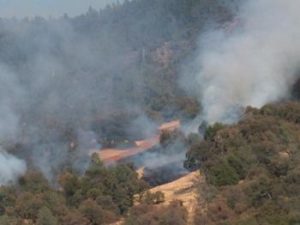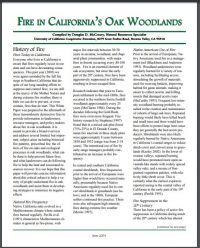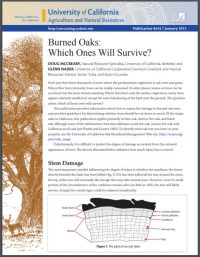 As the population of California continues to increase, the threat of wildfires also increases. This is because most wildfires are started by humans. It is also generally accepted that the threat of catastrophic fires is higher today than it has ever been. The primary reason for this is that after a 100 years of very successful fire suppression, the amount of fuels in the landscape is much higher than it was when periodic, low intensity fires regularly burned. In the past decade, some of California’s largest fires on record have occurred, including some in oak woodlands.
As the population of California continues to increase, the threat of wildfires also increases. This is because most wildfires are started by humans. It is also generally accepted that the threat of catastrophic fires is higher today than it has ever been. The primary reason for this is that after a 100 years of very successful fire suppression, the amount of fuels in the landscape is much higher than it was when periodic, low intensity fires regularly burned. In the past decade, some of California’s largest fires on record have occurred, including some in oak woodlands.
Fire in California’s Oak Woodlands
Download white paper that covers topics such as the history of fire, ecological effects of fire and how fires will affect oak woodlands in the future.
Burned Oaks: Which Ones Will Survive
Wildfire in an oak woodland can kill some trees outright and leave others with burn damage that may or may not eventually kill them, too. Here is a quick method for assessing the extent of burn damage and the likelihood that an affected tree will survive.
Harold Biswell was a Professor of Fire Ecology at UC Berkeley during 1947 to his retirement in 1773. Well before its time, he advocated controlled or prescribed fire to help prevent catastrophic wild fire. At the time, his advocacy met with considerable resistance from professional foresters and the public. However, his practices of prescribed burning have become the official protection strategy for federal and state agencies with the responsibility for protecting forests and rangelands. The video shows Harold Biswell in 1983 in a field teaching the importance of getting controlled fire back into the ecosystem.
CNPS Fire Recovery Guide
What should you do with your land after a wildfire?
The CNPS Fire Recovery Guide addresses that question in an easy-to-use booklet, created in response to the widespread Wine Country fires. The Guide is a collaborative effort between CNPS, North Bay partner organizations, and some of the best fire experts in the state.
View the CNPS page on fire recovery or download the guide from CNPS
California Oaks and Fire: A Review and Case Study
Katherine A. Holmes,2, 3, Kari E. Veblen,2, 3 Truman P. Young,2, 3 and Alison M. Berry2, 3
California has a fire-prone Mediterranean climate, and many of its nine species of native oak trees are thought to have evolved with fire. Little has been widely published about the role of fire in the oak recruitment and mortality in the western United States, and there has been some debate about how to reintroduce fire into oak woodlands. We present here a review, synthesis, and analysis of the literature on fire and California oak species.
This case study is posted elsewhere on the internet. Download here.


